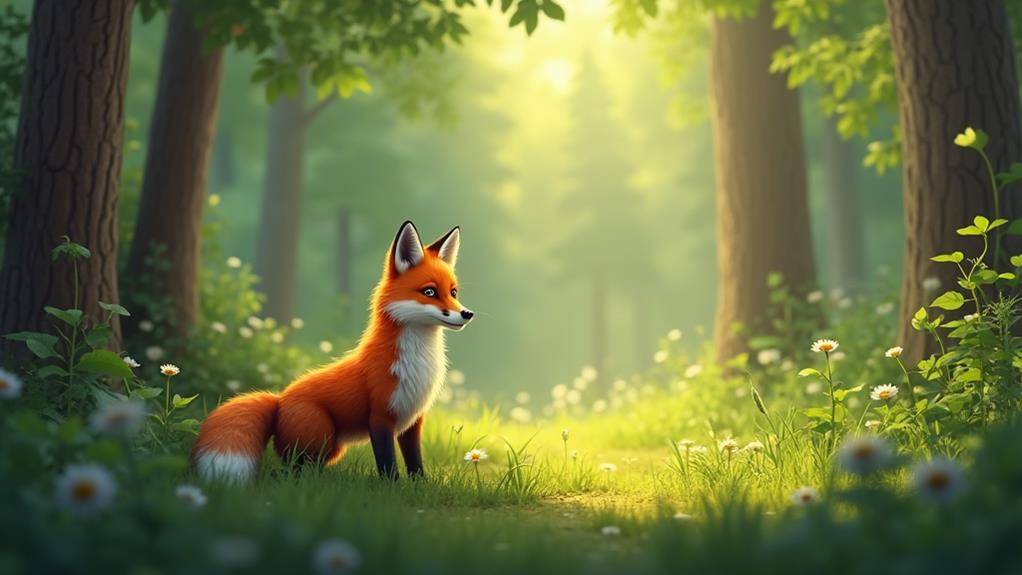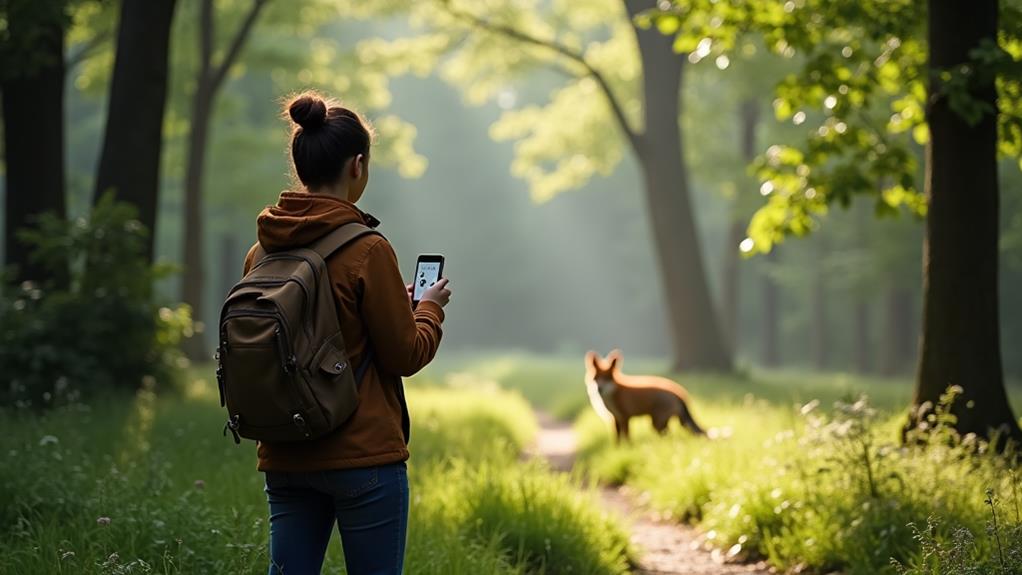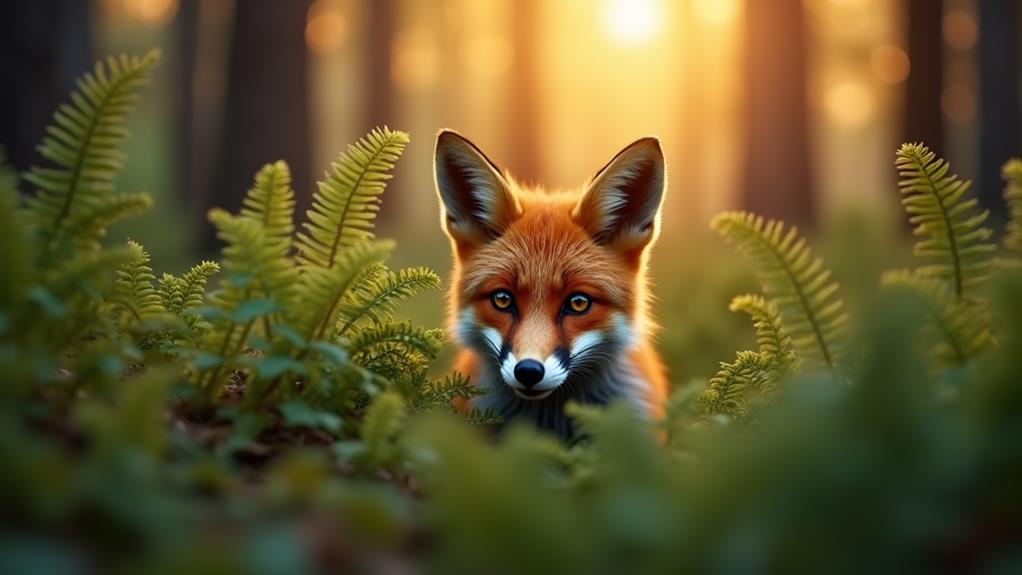When you see a red fox, first assess the situation from a safe distance—about 50 yards is perfect. Maintain your distance and avoid loud noises; you don't want to startle this shy creature! Make sure your pets are secure, especially small ones, as they might look like tasty snacks to a hungry fox. Observe its behavior—are they acting unusually? If so, it's time to report your concerns. Remember, these clever animals are adaptable, so keeping your trash secured is a wise move. Stick around, and you'll uncover even more tips about coexisting with our furry friends!
Contents
Assess the Situation

When you spot a red fox, it's important to assess the situation before getting too close. Take a moment to observe from a safe distance. Generally, healthy foxes are shy and will shy away from humans, a trait that helps them thrive in urban areas where they exhibit bold behaviors.
Look for any signs of illness, like unusual tameness or staggering; these may indicate something's wrong, like rabies. If you're seeing fox sightings during the day, it might be a sign that food availability is limited, especially in urban areas where these clever critters often roam, with their flexible diet often relying on household waste and scraps from humans (urban fox behavior).
Securing your pets is vital, too. Keep small dogs or cats indoors or closely monitored because foxes may see them as potential prey. It's a bit of a wild world out there, and we want to keep our furry pals safe!
If you notice that the fox seems injured or sick, don't go rushing in. Instead, contact local wildlife services for help. You'll be doing the fox and your community a kindness.
Maintain Distance
After evaluating the situation and determining that it's safe to observe, focus on maintaining a respectful distance from the red fox.
Red foxes are generally timid and prefer to avoid human interaction. By keeping your distance, you guarantee their natural behavior isn't disrupted and prevent them from becoming overly bold or reliant on humans for food. Plus, it's safer for you!
Here are a few tips to help you maintain that essential distance:
- Stay Back: Aim to observe from at least 50 yards away. This helps the fox feel secure.
- Use Binoculars: Enjoy the view without getting too close. It'll make your experience even more exciting!
- Avoid Loud Noises: If a fox gets a bit too bold, a simple shout from a distance can work wonders without escalating any defensive behavior.
- Watch for Signs of Stress: If the fox displays unusual behavior, like aggression or fear, it's time to ease back for your safety and theirs.
Secure Your Pets

Keeping your pets safe from red foxes is essential, especially if you have small animals like kittens or tiny dogs. Those adorable little furballs can be at a higher risk, so it's vital to keep them indoors or watch them closely when they're outside.
Urban foxes have adapted well to city life, often using parks and gardens as hunting grounds, which makes it even more important to protect your pets. Fortifying their housing is also a must. Think secure enclosures for rabbits or chickens—this can help prevent any sneaky encounters with our red-tailed friends.
When you're out and about, always keep your domestic dogs on a short leash, particularly in urban environments where foxes might wander. It's much easier to manage any potential confrontations that way.
Plus, remember to secure your trash and compost bins; feeding wildlife inadvertently could attract foxes, and that's the last thing you want around your pets. Urban fox behavior often indicates their adaptability in urban settings, making awareness significant.
Another tip? Increase human activity in your yard. Foxes are generally timid creatures, and a little extra foot traffic can make them think twice about venturing close.
Keeping your small pets secure will give you peace of mind, knowing they're safe and sound while enjoying their adventures around the backyard. Your diligence is the best defense!
Observe Behavior
Observing a red fox's behavior can be an enlightening experience, revealing much about these clever creatures. When spotting urban foxes, take a moment to quietly watch their actions.
Red foxes are highly adaptable and can often be seen in various urban environments, showcasing their knack for thriving in places influenced by humans. Here's what to look for:
- Hunting Patterns: Red foxes often hunt during the day. They adapt to their environment, seeking food resources that might surprise you, reflecting their adaptability and urbanization.
- Timid Nature: These animals are generally timid. A sudden noise or movement might send them scurrying away.
- Den Site Dynamics: It's fascinating to note how red foxes switch between multiple dens, especially during the breeding season. This behavior is essential for their kits' safety.
- Youth Foxes: If you catch a glimpse of youth foxes playing, you'll see their social behaviors in action. They interact with one another and develop important survival skills.
Report Concerns

Spotting a red fox can be exciting, but it's important to remain vigilant about their well-being. If you notice a fox displaying unusual behavior, like being overly aggressive or too friendly, don't hesitate to report your concerns. Local animal control or a wildlife helpline can guide you on how to help the fox and guarantee everyone's safety.
Keep in mind that red foxes thrive in a variety of habitats, which means they might be more frequent in urban areas than expected; this awareness can help in determining when to take action. Additionally, understanding the diverse fox species can further inform your observations.
If you come across sick or injured foxes, quickly contacting organizations such as the Toronto Wildlife Centre can make a big difference. Your swift action could lead to their rescue and rehabilitation. When you report, jot down the location, time, and specific behavior you observed. Detailed information aids wildlife authorities in their response.
Keep an eye out for fox dens near residential areas or increased fox activity. Let local wildlife management know so they can monitor the situation and implement safety measures.
Final Thoughts
So, the next time you spot a red fox, remember these steps like a trusty guide in the wilderness. It's essential to respect their space, keep your pets safe, and observe from afar. Think of it as sharing a moment with nature, like watching a live painting unfold. If something seems off, don't hesitate to reach out and report your concerns. With a little knowledge and care, you can enjoy these beautiful creatures without any worries!














